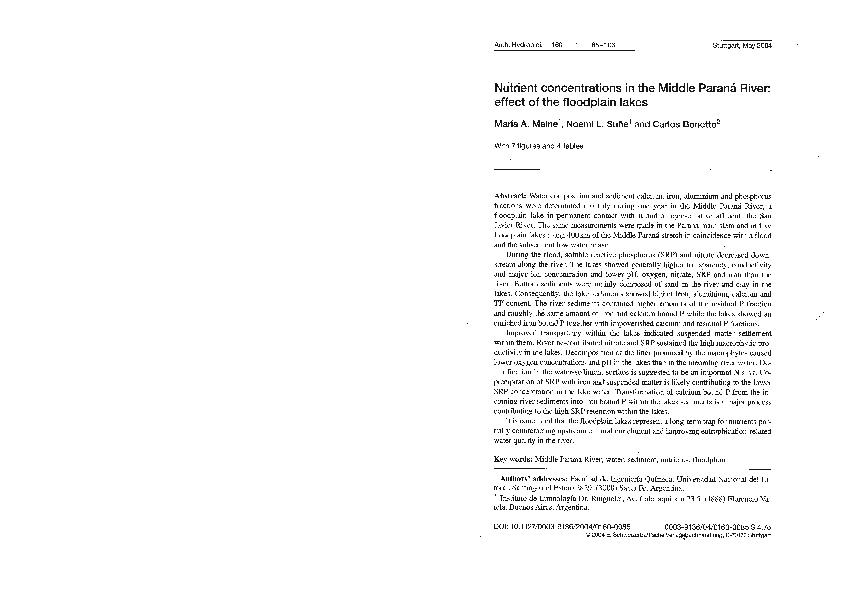Artículo
Nutrient concentrations in the Middle Paraná River: effect of the floodplain lakes
Fecha de publicación:
05/2004
Editorial:
E Schweizerbartsche Verlags
Revista:
Archiv Fur Hydrobiologie
ISSN:
0003-9136
Idioma:
Inglés
Tipo de recurso:
Artículo publicado
Clasificación temática:
Resumen
Water composition and sediment calcium, iron, aluminium and phosphorus fractions were determined monthly during one year in the Middle Paraná River, a floodplain lake in permanent contact with it and a representative affluent, the San Javier River. The same measurements were made in the Paraná main stem and in five floodplain lakes along 400km of the Middle Paraná stretch in coincidence with a flood and the subsequent low water phase. During the flood, soluble reactive phosphorus (SRP) and nitrate decreased downstream along the river. The lakes showed generally higher transparency, conductivity and major ion concentration and lower pH, oxygen, nitrate, SRP and iron than the river. Bottom sediments were mainly composed of sand in the river and clay in the lakes. Consequently, the lake sediments showed higher iron, aluminium, calcium and TP content. The river sediments contained higher amounts of the residual P fraction and roughly the same amount of iron and calcium bound P while the lakes showed an enriched iron bound P together with impoverished calcium and residual P fractions. Improved transparency within the lakes indicated suspended matter settlement within them. Riverine-contributed nitrate and SRP sustained the high macrophytic productivity in the lakes. Decomposition of the litter produced by the macrophytes caused lower oxygen concentrations and pH in the lakes than in the incoming river water. Denitrification in the water-sediment surface is suggested to be an important N sink. Coprecipitation of SRP with iron and suspended matter is likely contributing to the lower SRP concentration in the lake water. Transformation of calcium bound P from the incoming river sediments into iron bound P within the lakes sediments is a major process contributing to the high SRP retention within the lakes. It is concluded that the floodplain lakes represent a long-term trap for nutrients partially counteracting upstream cultural enrichment and improving eutrophication-related water quality in the river.
Palabras clave:
Water
,
Sediment
,
Nutrient
,
Floodplain
Archivos asociados
Licencia
Identificadores
Colecciones
Articulos(CCT - SANTA FE)
Articulos de CTRO.CIENTIFICO TECNOL.CONICET - SANTA FE
Articulos de CTRO.CIENTIFICO TECNOL.CONICET - SANTA FE
Articulos(ILPLA)
Articulos de INST.DE LIMNOLOGIA "DR. RAUL A. RINGUELET"
Articulos de INST.DE LIMNOLOGIA "DR. RAUL A. RINGUELET"
Citación
Maine, Maria Alejandra; Suñe, Noemi Liliana; Bonetto, Carlos Alberto; Nutrient concentrations in the Middle Paraná River: effect of the floodplain lakes; E Schweizerbartsche Verlags; Archiv Fur Hydrobiologie; 160; 1; 5-2004; 85-106
Compartir
Altmétricas




